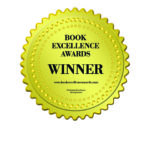PRESIDENT’S MESSAGE

Hello friends and fellow writers,
Another holiday season is upon us which means a lot of different things to a lot of different people. I hope you enjoy spending time with loved ones regardless of the reason. Laughter is always good medicine especially in these dark times (at least for those of us living in winter states). The most important realization for me during the holiday season is that another year is almost over with a bright, shiny new one waiting in the wings. It can be disappointing when I realize that my “Want To Get Done” and my “Actually Got Done” lists aren’t congruent but it can also be very exciting when I realize that time is actually a social construct and I have plenty of time to get things done. That doesn’t keep me from making a lot of lists. Of course, I usually promptly lose the list.
Recently I’ve been struggling with how much research is too much. When do you stop looking things up? Especially since for me this looking often is like following Alice down the rabbit hole. But then doesn’t everyone end up learning about the habits of mutated fruit flies when they wonder what Pavlov’s dogs’ name were? Thank goodness I’ve got the Public Safety Writers Association and the friends I’ve made. I reached out and asked the question about when to stop the research and start the writing. The response was supportive and practical. I was reminded to think about who my audience was and what they expected from me-a doctorate level researcher or a subject matter expert with practical experience. This reminder led me to a good timeline with a focus on what information I still needed to brush up on with an eye on getting to the good stuff-the writing.
The networking and support are just a small benefit to being part of the PSWA. Speaking of benefits, don’t forget about the early bird pricing for the conference in July or the opening of the writing contest (January 1, 2019). There are so many good things to come both with the new year and with PSWA. I’m glad you are all taking this journey with me. I look forward to sharing new successes with each of you as we enter this last year of the twenty-tens.
—Michelle J.G. Perin-Callahan, President, PSWA
BEATING THE DEADLINES

I had a couple of tight writing deadlines this month. One was an Executioner manuscript, Stealth Assassin, I had to turn in by November 5th. I also had to review of the copy edits on Legends of the West, my forthcoming Bass Reeves western. I managed to beat both of them. But more deadlines are looming. I have to come up with another scenario for Mack Bolan to save the world and I need to finish an editing job that I’ve had on hold for way too long. But none of these is as important as the deadline for the end of the early bird pricing for the PSWA conference (December 31st).
We’ve extended a couple of great offers this year, including a special discount if you convince two new people to register for the conference. There’s also a “no cancelation” rate. Check them out on the website. It goes without saying that the conference is our main event each year, and I personally think it’s the preeminent event of its type. The price is very affordable, and the hotel rates are extremely reasonable. Make sure you take advantage of the conference rate offered by the Orleans Hotel. The code is posted on the website. I’ve usually found the best way is to call the hotel directly and mention you’re attending the PSWA Conference. The staff is very helpful.
Our PSWA Board is working very hard to make the next conference even better than last year’s, and attendees rated that one as one of the best ever. We’ve got some dynamite solo presenters lined up. Retired Deputy Chief Dave Freedland of the Irvine, California PD, will talk about real life SWAT tactics and the various call-outs he was on during his police career. Our PSWA Vice President and retired copper, John Schembra, will give you the low-down on police pursuits and high-speed chases. Author and publisher, Mike Orenduff, creator of the highly praised Pot Thief series, will talk about going from an unknown to a best seller. And highly successful short story and screenwriter, Mysti Berry, will show us how to turn real life into fiction by asking the dramatic questions to focus your story.
If those aren’t enough to whet your appetite, I’ve got a bevy of interesting panels on a variety of subjects. Speaking of panels, I’m always open to suggested topics so send any you have to me at DocAtlas108@aol.com. We’ll also have our PSWA bookstore to sell your books and a variety of excellent meals, which are included in the conference. We’re also offering our pre-conference writer’s workshop, where you can get one-on-one feedback and writing instruction from at least three published writers. Since there’s been so much interest about possibly doing another PSWA Anthology, we’re highlighting writing short stories at this year’s workshop, but the writing principles can be applied to any type of writing. You can also have up to 25 pages of your manuscript critiqued by one of the workshop instructors at the workshop. (It’s required that you send it in advance.)
At this point I’m working hard to find another old time radio play, and there will of course be lots fun and stimulating conversation. There’s no better place to rub elbows with the actual experts who’ve walked the walk and know what’s real and what’s not.
Don’t hesitate. Sign up today. You won’t regret it.
—Michael A. Black, Program Chair
NOTE FROM THE NEW TREASURER

Don’t worry, Nancy Farrar is staying on the board and staying with PSWA—no one could replace Nancy! However, I am taking on the Treasurer duties and am looking forward to helping out in this new capacity. If all goes well, you won’t even notice a difference until you see me seated behind the book-selling table in July.
Nancy’s done an amazing job and I only hope I can follow in her footsteps!
—Mysti Berry, Treasurer
APPEARING AT EVENTS, BOOK FAIRS, AND CRAFT FAIRS

The holiday season is upon us and many writers will be attending holiday craft fairs, book signings, speaking events, and whatever else they do to promote or sell their works. It is a great time to get the word out about your books and who you are as a writer.
I believe that when we are at these events, it is not just about your books. You are also presenting yourself as a writer and a person, and it is imperative that you make a good first impression.
First, have an attractive table or display. A table cloth is a must. The display should be neat and nicely arranged, not cluttered and hap-hazard. There should be a synopsis of each book, if possible. Usually the back cover blurb is sufficient, but I like to write a bit more to catch the person’s interest. Have a copy of the book displayed with it.
Invest in a banner that can catch people’s eye. Post it on a wall behind you, or, as I do, have it hanging off the front of the display. It can be simple- mine merely has my name, “Award Winning Author” and my website on it. I have seen others that also have the author’s picture or book cover(s). Just be careful it isn’t too busy.
On her blog tour, Marilyn Meredith wrote about attending craft fairs and gave some great advice. If I may borrow from her post, she said to not be too aggressive with potential buyers. I agree 100% with her. If someone stops at my display, I greet them pleasantly and ask if they like to read, as an ice breaker. If it appears they aren’t interested in talking, I just tell them to ask if they have any questions. If you can, when someone approaches your booth, stand to greet them. I believe that shows your interest, and appreciation, of them stopping by.
If they do respond and seem willing to talk, I give them a short bio of my books, and myself. I have found once that occurs, they tend to hang around longer, talk more, and that ups the chances of a book sale. Don’t be shy- if you have won writing awards, say so.
I also suggest you post the price of the books, and that you accept credit cards. My price list offers a discount if they buy multiple books, which seems to interest them.
Dress nicely! First impressions of you are important. No need to dress as if you are attending the Queen’s Ball–casual and neat is good.
I always have some Hershey Kisses in a bowl on the table as a give-away. That seems to work on getting them to stop by, giving you the opportunity to meet and greet.
Finally, have some promotional materials displayed- bookmarks, pens/pencils, business cards, etc. Give them out liberally, not only to people who stop by, but ask those passing by if they would like a card or bookmark or whatever you have. I have found that increases the number of visitors to my website for a week or two after the event.

I sometimes ask the potential customer if they have ever thought about becoming a writer. More often than not, they say yes. That opens the door for you to give some simple advice about writing and getting published. I’ve found these customers often buy a book or two, and seem genuinely grateful for the info. Place a bookmark in each book sold, and don’t forget to ask them to submit a review when done reading it. I usually tell them the review can be very short, or as long as they want it to be, and explain, briefly how important reviews are to authors.
The holidays provide the best opportunity to promote yourself and your books, and sales could be brisk or not so brisk. Don’t be disappointed if you don’t sell a lot. As long they leave your table with a way to access your website, the potential is there for a future sale!. Don’t overlook other holidays during the year, or craft fairs, though. Google craft fairs in your area to find the best choices for you.
Now, I can’t end this without reminding you of the PSWA conference in Las Vegas, in July. A wonderful, fun, and educational event! Check it out at the PSWA website: www.policewriter.com. The early bird registration is good through Dec. 31, when the price will go up. Still, it is the most affordable conference. The special room rates at the Orleans Hotel are great, the lunches (included) excellent, and it is a fun time for all. Sign up now to take advantage of the discounted cost.
—John Schembra, Vice-President
MENTORS

I wonder how I would’ve ever gotten where I am today without mentors. This includes the mom down the street who took me under her wing when my mother was busy with her own demons. During my career, there was a motor officer who introduced me to the concept, “badge-heavy” and changed my adversarial attitude with the public while issuing tickets. Fred, a patrolman, was another crucial association. He invited me to testify to the county grand jury as part of an investigation of our police administration. Standing up for the integrity of the job was a beautiful burden. These people were life-mentors who taught me valuable lessons that extend through my life today.
But let’s talk about mentors who help writers.
In any other industry, colleagues could look upon newbies as competition. While I’ve found that writing teachersaren’t necessarily mentors, I can say I have never seen professional acrimony. The motto of my local writing club, Redwood Writers’ (a branch of California Writers Club) is “writers helping writers.” Indeed, my first true writing mentor, Patsy Taylor, during her Jumpstart Writing class, encouraged me with provocative prompts. She provided a safe place to read and hone my own stories. Then, she pointed me toward the club, where I found much more to learn.
My second mentor is Marilyn Meredith. As you know, she’s a board member of the Public Safety Writers Association who I met in 2014 at our annual conference. Marilyn is a mature lady—and I say lady in the most respectful terms—who helped me navigate small press publishing and writing ethics. She’s a prolific author of over 40 books who gets up in the middle of the night (4 AM) to accomplish her myriad goals. Even with huge family demands, she writes and promotes almost every day. She’s a model of Christianity—not the clichéd version—the true-blue follower of Christ. She’s unpretentious, accepts people the way they are and believes in sharing her gifts—as she has with me. I’ll bet she never even considered herself a mentor. But she is.
Speaking of not considering yourself a mentor, now I want to talk about being a mentor. Why?
- It could change someone’s life—really. Think about words of encouragement you heard that motivated you. Be that person.
- It will take you out of your own world—we create them in our heads, don’t we? Telling another person about your process attaches words to abstract thoughts. Sharing can enlarge thoughts, if you listen.
- You’ll be building a writers’ community based on the positive aspects we’re talking about here.
- The life you change may be your own. Sometimes, verbalizing the process gives us a clearer picture. Sharing and giving aren’t unique to humans but we’ve refined it through evolution. Let’s keep working on it.
Be sure to join us on Writer’s Notes, Just the Facts, Ma’am
—Thonie Hevron
Webpage www.thoniehevron.com
Blog: https://thoniehevron.wordpress.com/
STOPPING DRONES ON THE BATTLEFIELD

It seems drones are ubiquitous. From personal use, to commercial applications, and finally, military deployments. Drones are available and used globally, it’s a billion-dollar industry. Their relatively inexpensive price tag makes it easy for everyone to purchase, including those bent on destruction and mayhem.
Our old nemesis, Russia, utilized drones when they invaded Crimea. The unmanned aircraft systems were used to identify enemy soldiers on the ground. Once spotted, the drone operators simply relayed coordinates for missile and artillery strikes. ISIS has also begun using drones in their battle plans, and the drone threat has been employed by terrorist groups in conflicts from the Middle East to Eastern Europe.
Stopping the threat
The U.S. military recognizes the enormous threat drone usage poses and has come up with a solution. Introducing the IXI Dronekiller. This new hand-held device is the first of its kind, and, according to IXI Technology, employs counter-drone technology that uses software defined radio. A company official explained that the new weapon is not a broadband jammer like one can purchase online. It targets whatever specific frequency drones are operating on. The IXI official explained that every drone has a different type of frequency. For instance, the DJI Phantom, a common commercial-use drone, operates on the 2400 to 2483 MHZ frequency, or 2.4 GHZ band. Within that 2.4 band an operator selects different channels to link between them and the drone itself.
The latest iteration of the DJI Phantom drone is capable of hopping channels. However, the IXI Dronekiller can counter that ability. The new weapon is not simply blocking a whole channel, but rather inserting a bit of noise or additional data to break the link between drone and operator. The Dronekiller is able to target all Type I and Type II commercial drones, the type seen by non-state, and/or some state actors and employed on battlefields like Syria, Iraq, and Afghanistan. These commercial drones are used by many terror groups for surveillance, but occasionally they add a bomb to drop on their adversaries.
Last year in Syria, fighters from a Christian militia reported they uncovered what they described as an ISIS drone factory. The theory was that ISIS was building drones from spare parts. However, whatever is built and regardless of frequency, the Dronekiller can identify the frequency and neutralize the threat. The IXI has a radio frequency sensor that can acquire all drone signals in roughly three seconds.
How it works
The new Dronekiller is simple to operate and the user training time is less than one minute. It’s a point and shoot gun with a 30-degree cone of effect on whatever threat is targeted. Simply point the weapon in the direction of the target and when the drone flies into the cone it either crashes, if it’s a cheap one, or a more advanced drone will fly back to base. If it heads back, the IXI can follow it and see who was flying it. A newer version of the device can also be mounted to an assault rifle, similar to attaching an M203 grenade launcher.
The IXI Dronekiller’s specs include a four hour battery life in active mode use, a rechargeable Lithium-ion battery, right or left hand operation, an environment-resistant frame, a weight of 7.5 pounds, and a range of one kilometer.
The new system is being tested by Marines at Camp Pendleton, California, as well as Ft. Bragg, North Carolina by the Army. Oceanside Police Department in San Diego, California and the Los Angeles County Sheriffs Department already use a version of the IXI to attack commercial drones violating airspace regulations during events like the Golden Globes and Rose Bowl.
Good and bad
Drone usage is on the rise and so is the ability to intercept them and their frequencies. Recently, at Apple, an individual was caught using a drone to film construction of the company’s new campus named Apple Park. The user was quickly identified and ordered to stop.
Drones are also used for legal purposes such as helping companies to better view their construction sites, real estate properties, or filming farm operations. On the other hand, people find new ways to use drones for illegal purposes. Prisons have reported contraband, such as tobacco and drugs, being flown over gates and walls. In time of disasters, curiosity seekers have been known to fly their drones for better views of damage due to hurricanes and tornadoes, or of firefighters fighting a blaze. Instances such as these have prompted the FAA to step in and ban drones interfering with rescue or recovery efforts.
The military has also been affected by civilian drones. Some operations, including Coast Guard drills, Air Force maneuvers, and one involving a Central Command pilot buzzed by a drone last year while attempting to land on an aircraft carrier in the Persian Gulf.
Cost
Technology is expensive but necessary. The U.S. military’s spending on drones is set to reach a five-year high. The DOD fiscal year 2018 budget request contained $6.97 billion for drone-related procurement, research and development, and system-specific construction. The FY 2019 budget request is approximately $9.39 billion. The proposal includes funding for the procurement of 3,447 new air, ground, and sea drones. This is an increase from the 2018 procurement of 807 drones.
—John M. Wills
Award-winning Author/Freelance Writer
Public Safety Writers Association member
www.Jwillsbooks.com
ARE YOU PAYING TOO MUCH FOR MEDICATIONS?

This article has nothing to do with the business or art of writing. I thought I would get that out of the way at the outset.
This is about prescription medications, and the prices we pay for them. I have noticed that most of the membership of the PSWA is of a “certain age,” and even the younger members take prescription medications now and then. This is about how they are priced, and how you can more easily find the best bargains.
Besides being the PSWA’s Alpha Geek, I have a day job as a combination information technology manager, medical assistant, and covert security officer (the patients don’t know that the old fat guy who takes their blood pressure is packing heat) for a psychiatrist in private practice. For those of you that think I should see a shrink, take comfort in knowing that I see one four days a week.
One of my duties is to process the prescriptions written by the physician I work for. He tends not to write prescriptions for the “latest and greatest” medications, as they are seldom covered by insurance and are too costly for most of our patients. Nearly all the prescriptions I process are for medications that have been available in generic form for years.
A brief tutorial might be in order with regard to brand name vs. generic medications. When a pharmaceutical company discovers that a compound is effective in treating a particular disorder, they must first get it approved by the Food and Drug Administration (FDA). This requires years of animal and human trials, and is enormously costly. These costs are in addition to all those expended in trying out other compounds that might turn out to have no worth at all.
The pharmaceutical company (aka Big Pharma) then gets a patent on the medication, which gives them a monopoly on its manufacture for at least 20 years. They can charge as much as the market will bear in order to recoup the costs of their research and clinical trials. If the drug is one that people either need very badly (say, Gleevec, which is used in the treatment of some cancers), or one they just want very badly (like Viagra), the company makes buckets of money. A course of Gleevec costs about $84,000 per year in the U.S., and brand name Viagra is around $75 per dose.
Once the patent expires, other pharmaceutical companies can make the drug, and they usually do. The cost of the generic is typically a fraction of the brand name. Generic Gleevec (imatinib) runs around $24,000 per year, or about $28% of the brand name price. Generic Viagra (sildenafil) is about $23 per dose.
Once the drug has been around for a long time, multiple generic manufacturers pick it up, and the price goes down even more. A month’s supply of prednisone, a common steroid used to treat all sorts of inflammations, can be had for about $5 at some pharmacies.
Of course, few retail pharmacies publish their prices (Costco is an exception), so, if you want to find the best price, you have to ask or call around. All pharmacies will tell you their price for a specific drug and dose, but only if you ask. If only there was an easier way.
There is, and that is why I am writing this. We make extensive use of a smartphone app called GoodRx. There is a version for both iOS (iPhone) and Android flavors, and if you don’t have a smartphone or don’t want to download anything, you can go to the GoodRx website (https://www.goodrx.com/). If you don’t want to use a computer at all, I have to wonder how you are reading this.
GoodRx allows you to key in the name of just about any prescription medication, and choose generic or brand name, the dose, and the quantity. If you’re using a smartphone, the GPS feature will know where you are and search for local pharmacies. Online, you’ll need to enter a zip code.
You’ll be presented with a list of prices for your drug at area pharmacies, ordered from cheapest to dearest. Be prepared for a shock at the difference between the prices at the top and bottom of the list.
For example, clomipramine (brand name Anafranil) is used to treat obsessive-compulsive disorder. Where I live, a 30-day supply costs $177 if you get it at Walmart. However, if you take your trade to Fred Meyer, about a mile away, you will pay $403 for exactly the same drug.
So, why do two supposedly discount pharmacies charge such different prices? Each has different buyers, different contracts, and maybe even different manufacturers. Americans pay more for prescription drugs than citizens of any other first-world country because we are the only one that doesn’t have a national health care system. In other countries, the government negotiates with Big Pharma for drug prices, and everyone in the country pays that price.
Here, we have umpty-ump health insurance providers, most of whom contract with one of a few pharmacy service companies like Express Scripts, Cigna (soon to be just Cigna, as they bought Express Scripts), Kaiser, Optum Rx, etc. They negotiate prices, and your insurance provider pays that price.
Unless—you don’t have insurance, or you have a lowball plan that doesn’t include prescription coverage or covers only very basic medications. Then, you pay whatever your pharmacy wants to charge you. GoodRx tells you what they want to charge you.
You’re better off getting your medicine from a single pharmacy, if you can. The pharmacy will have a record of all your medications, and they can flag any potential adverse interactions. This is especially important if you see multiple prescribers who may not be aware of what one another are doing.
This may involve a judgment call, where you balance the utility of getting your scripts at a single pharmacy against paying the lowest price by shopping around. However, there are some ways you can work the system to your benefit.
- Many of the prices listed on GoodRx are marked with a button that reads “coupon.” The coupon is a virtual one that appears if you click that button. At the pharmacy, show the clerk the screen that appears, and you will get your discounted price.
- If you normally take your trade to Pharmacy A, but Pharmacy B has the better price on a drug you need, show the pharmacist the price you can get at B by showing them the GoodRx screen. Many pharmacies will match the price to keep your trade.
- GoodRx doesn’t usually list the prices of mail-order pharmacies. The mail-order outfits can sometimes offer a better price, but they usually require ordering a 90-day supply. Your prescriber will usually authorize this once you are stable on a medication regimen and the dose is no longer being titrated (to determine the optimal dose for you). The mail-order pharmacies do list their prices online, so you can compare costs.
- If GoodRx or some other strategy yields a very low price, like $5 for a month’s supply, keep in mind that is probably the cash price, not the one you will get through your insurance plan. Most health plans mandate a minimum co-pay for prescription drugs, typically $10 or $15. If you insist on running the prescription through your insurance, you’re going to pay the co-pay out of pocket, even if the pharmacy would give you the drug at the lower price. Just tell the pharmacist you’ll pay the cash price, and save yourself the price of lunch (maybe not a big lunch).
- Finally, a tip unrelated to cost: take advantage of the pharmacist’s expertise. If you’re fortunate enough to have a physician who takes the time to explain all of the ramifications of taking a medication, count your blessings. Many physicians are eternally pressed for time, often seeing multiple patients at once, and while they would like to explain each treatment decision carefully, there is not always time. Pharmacists are also pressed for time, being charged with filling X prescriptions per hour. They will, however, take the time to explain any potential side effects and drug interactions, and many pharmacies require them to offer you counseling when you pick up a new medication. Take a minute and let them do so, even if your physician briefed you already. This is potentially life-saving (or life-threatening) information, and it doesn’t hurt to double-check.
—Tim Dees is a retired police officer and the former editor of two major law enforcement websites who writes and consults on technology applications in criminal justice. He can be reached at tim@timdees.com.
MARKETING IDEAS YOU MIGHT NOT HAVE CONSIDERED

A suggestion came from a friend who is clever about marketing, and at a time when I didn’t think I could write another police procedural. I put together a 15,000 word EBook relating everything I knew about “Writing Your First Mystery.”
I am not one of those people who just loves, loves, loves, writing. It’s intellectual manual labor. But I had fun sharing what I knew, which isn’t the case with the novels. To date it’s spurred 29 Amazon reviews and a 4.5 rating.
People liked it and bought it. I aimed toward the novice, and to the seasoned writer who might want to try a new genre, or wants to be reminded of the basics. So I wrote another one: on characterization, and a few more: plotting, backstory, editing, and importantly “Finishing Your First Mystery.” They’re getting longer, up to and more than 20,000 words. “Writing Suspense in Your Mystery and Thriller Fiction”, the 7thin the series is now available.
My focus has broadened to include thrillers and the very different way they’re constructed from whodunits. I’m responding to reviewer’s comments. They’re cheap at $2.99.
A few years ago I put the first four together in a bundle at $5.99. One reviewer said: Mar Preston’s 4-volume series on how to write a mystery is the best I have ever read. Succinct, precise, and wasting no words, each book is the perfect guide to getting it right. Written in understandable and easy-to-follow instructions the series takes the reader from first idea to final draft.
Now that there are seven, I’m working on putting all 7 together and publishing them as a paperback 200-page book. You’d think it would be easy. Just string ‘em together. Not so. What feels like repetition comes from the same topic covered with a different angle of penetration. Like every other writing task, this is plain work. For another thing, I’ve learned things since the first one was published years ago. The marketplace slowly changes. Lots of links had to be researched.
A series of EBooks on a topic you know well might be a new direction for you. I’m not rich, but I have connected with new readers and writers I dearly love from EBooks.
If you like, you can see all of them through this Amazon link.
—Mar Preston
VISITING BLOODY SCOTLAND
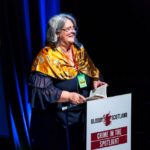
I’m not swearing, honest! It’s the name of the conference: Bloody Scotland.
In Scotland, they sell more crime books than any other genre (even romance, which is the top seller in the United States). So it was my great honor to visit the Bloody Scotland conference in Stirling last September. They invited me to read as part of their “Crime in the Spotlight” program: entrants compete for a dozen slots to read for two minutes, before the big panels of the conference. Crime in the Spotlight writers are a sort of appetizer for the audience, and a great way for newer writers to gain confidence in front of audiences.
Some things were very different at Bloody Scotland compared to American crime writing conferences, and some things were exactly the same.
The Differences
Conference organization: You pay about $10 for each panel, and a few events are free to the public. There’s no conference fee. This has the advantage of letting the conference organizers know for sure which events are the biggest draw, and which they can safely book in smaller venues. The disadvantage, obviously, is that the most popular talks sell out months in advance of the conference. Free coffee in a few places, but all meals were on the attendees, except for the master class (more about that in a minute!)
Conference location: The base of the conference is in the 250 year old Gold Lion Hotel, which once hosted Robert Burns! Talks are scattered between the hotel and the City of Stirling venues designed to hold 800 or so people. The conference provides a jitney to help disabled people get to the big hall and back, though if you don’t get lost like I did, it’s a short walk up a San Francisco-worthy hill. The conference does its best to accommodate people with disabilities, but it is a tougher job to get around in a wheel chair or with a cane than conferences that take place almost entirely in one hotel. That said, the hotel staff are funny and welcoming, the building is fascinating to any of us who were born and raised in California, where mid-century seems like old for a house!
Stirling has a fascinating history as part of the sad life of Queen Mary, and its very own castle. The people I met in Stirling, from restaurant employees to hotel staff to the brilliant, hardworking folks who run Bloody Scotland were to a person kind, funny, and engaging. Some were more blasé about tourists than others. But I met half a dozen very talented writers and I look forward to staying in touch with them.
Bloody Scotland was able to entice the long-lived and entertaining writer M.C. Beaton, wee lady whom you can believe delivered a “Glasgow Kiss” in her earlier years, and Ashley Jensen, star of the Agatha Raisin TV series based on Ms. Beaton’s books. Ms. Jensen and Ms. Beaton are very funny, smart women, and they regaled the audience well into the Saturday night.
A few features are uniquely Scottish, like the incredible selection of whiskey in the hotel bar, and the satirical, Beyond-the-Fringe style revue that both celebrates and pokes fun at the traditional mystery. Also, I noticed that dark crime stories far outnumbered cozies and PI stories. Scotland, like its neighbors to the north in Scandinavia, embraces the dark side of fiction.
Unique Events: Two unique features of this conference that other big conferences might consider adopting: Crime in the Spotlight and Pitch Perfect, a pitch-to-win competitive event. The Crime in the Spotlight crew gave us nervous newbies time to rehearse, coaching when our reading ran too long, and so much encouragement. Pitch Perfect is also a competition, you submit a pitch package, and they choose half a dozen of the applicants to give live pitches. The winner is introduced to a publisher. Previous winners have been published!
There were other unique events that I was unable to get tickets for: a raucous trivia game, and even more raucous soccer (rugby?) game, and a musical performance by some famous Scottish writers that literally sold out five minutes after the tickets were made available online. These events are rumored to be fantastic—though they did seem to give many people serious hangovers. Guess I’ll have to go back again to check them out! And everyone’s favorite, a torch-lit march from the castle to the hotel, is something we can’t replicate here in America, being so short of castles!
The Similarities
Multiple talks are scheduled at the same time and the conference had short turnaround times between panels, just like the bigger U.S. conferences. You have to be pretty good at scheduling to see your top five panels. (Of course, the PSWA conference ensures you access to all panels and events, but I think we are unique in offering only one panel at a time for a multi-day conference.) Writers, agents, publishers, and readers mingled in a friendly fashion, just like in the U.S.: conferences are a place where people can indulge their love of reading and writing, the world over.
The day-long master class held the day before the conference was well worth the money, hitting both craft and marketing topics. Everything discussed was useful no matter in which country you plan to publish your work. I heard fantastic pitches, received great advice, and met some writers I hope to stay in touch with!
Another similarity—the conference organizers ran themselves ragged to ensure each attendee had a great time. So whichever conference you go to, don’t forget to compliment people when things go well, and of course let someone know if you aren’t having a great time. But I try to be gentle, as I know anyone I talk to is sleep-deprived and exhausted from all the work they do.
Should You Go?
Should you go to a foreign writers conference? I went because I love Edinburgh (part of my family came to America from Ayr, west of Edinburgh), I had some research to do there, and because I placed in their Crime in the Spotlight competition. Scraping together the money was challenging: I blew my budget when unseasonably high winds knocked out the train service from London to Edinburgh and I had to find a last-minute substitute—a distance about the same as SF-LA. But surprises like this are the challenges of any trip out of town: the unexpected, which is part of the reason we travel in the first place! I will say that no one made any assumptions about my politics based on being an American. Everyone can tell you are an American from a dozen yards away—we walk and dress like Americans; even before we speak, they know we aren’t from Scotland. I’m glad I went, and hope to go back one day, possibly after a lottery win…
People are at the conference to share and learn. I was a very quiet version of myself at the conference, wanting to soak it all in and learn as much as possible. I swapped business cards with half a dozen people, and came home exhausted but happy I’d gone.
If you can afford it, and if you are already interested in the location where the conference is taking place, it really is a grand adventure to talk about mystery, crime, suspense, and forensics with people from another country.
Here’s a list of the conferences in the UK that I’ve been to or who generally have a great reputation:
- Bloody Scotland, Stirling, Scotland
- Crimefest, Bristol, UK
- Theakston Old Peculier Crime Writing Festival, Harrogate, UK (near the Yorkshire Dales National Park)
If you do go, try to take as much extra time as possible. There’s so much to see in Scotland, and despite the dour stock characters you may have seen on television’s Misdomer Murders, the Scots I met were to a person kind, welcoming, funny, and knowledgable about the wide world. A true joy to visit. Of course, if it’s a bit out of range, there’s always the PSWA conference the most friendly, cost-effective, and fun writing conference! Early bird rates end December 31st!
—Mysti Berry
PSWA Treasurer and Web Wrangler
SPOILER ALERT! There is No Such thing as “Crime Prevention”
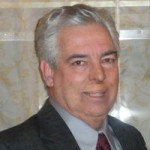
If you are a frequent follower of this newsletter, you know that I give personal safety tips and advice. I do this with a motive to help lower the chance of you or a loved one becoming a crime victim. But in this article, I’m going to address a reality of the crime prevention concept…or should I say “crime prevention myth.”
Most large police departments and sheriff offices have some commissioned or civilian employees assigned as Crime Prevention Specialists or Crime Prevention Practitioners. Their basic responsibilities generally consist of setting up Neighborhood Watch block areas, giving CPTED advice to business and homeowners, developing Crime-Free Multi-Housing Programs, teaching children safety at schools, providing personal safety tips to social groups, and even dressing-up as McGruff – the Crime Fighting Dog at National Night Out and other community events. Even though (by title) I was a Crime Prevention Specialist five years for the Las Vegas Metropolitan Police Department, I’ll be the first to make the assertion that there is no real thing as “crime prevention”, and the term is a misnomer.
The basis for my claim begins and ends with a few definitions (Dictionary.com);
“Prevention” (root word…prevent):
- to keep from occurring; avert; hinder.
- to hinder or stop from doing something.
“Misnomer”:
- a misapplied or inappropriate name or designation.
- an error in naming a person or thing.
My foundation for this allegation is to ask this question, “Is crime really prevented?” I think we all know the obvious answer to that. If crime was really prevented, according to definitions, there would be no need for cops or any enforceable authority, right?
The word “prevention” pops-up in other fields besides just law enforcement. Fire departments have units called “Fire Prevention” manned by fire inspectors. These specialists enforce codes and ordinances to reduce the chance of a fire hazard. However we know that sometimes these laws are violated, either intentionally or unintentionally, and a tragedy occurs. When Smokey the Bear says, “Only You Can Prevent Forest Fires,” there is some truth to that until someone violates a fire warning, or carelessly creates a fire hazard with smoking, camp fires, power tool usage, improper or no spark arrestors on motor bikes on off-road vehicles, etc..
Even health organizations and scientific research in the pharmaceutical industry, for the most part, have eliminated (i.e., prevented) certain medical issues, that is just as long as their prescribed practices are followed by patients.
So what’s the common thread or bottom line to all this? The Human Factor. Nothing is going to be 100% “Preventable” as long as there are people. Specifically people who take the attitude that “Rules Don’t Apply,” or that “Rules Are Made to Be Broken.” No matter how many locks, cameras, lights, or other crime fighting devices one uses to secure their possessions and property, there will always be someone who wants to take what is not rightfully theirs or break laws.
Yes, there is a need for these specialists and practitioners to offer and give safety tips and guidelines to potential victims of all ages. However, until the day that there are no more criminal acts, their rightful title should not include “prevention.” Instead, I contend Crime REDUCTION Specialists and/or Practitioners is more appropriate. Why? Because…
“Reduction” (root word…reduce):
- to bring down to a smaller extent, size, amount, number, etc..
- to lower in degree, intensity, etc..
So remember that when I pen one of my usual safety tips in the PSWA Newsletter, it’s only suggesting techniques that will reduce the probability of you becoming a crime victim…provided you follow them.
Happy Holidays and Stay Safe!
—Ron Corbin, Ex-Crime Prevention Specialist and “newly self-proclaimed” Crime Reduction Practitioner
Phdav8r@yahoo.com
HED: AVOID RECURRING CREDIT CARD CHARGES

I order quite a bit of stuff online, and subscribe to various paywall services that will happily give you a heavily discounted subscription in exchange for allowing them to automatically charge your credit card at renewal time. Some of these services have the tenacity of mosquitoes, being very slow to cancel your subscription when you decide you don’t want it anymore, or just don’t want to pay the full price for it.
For example, tonight I saw a reference to an article about the new 2019 Subaru Forester on the Wall Street Journal. As I am scheduled to take delivery on this car in a week, I was interested. However, I could read only the first two paragraphs before I was presented with a demand to either log in or subscribe if I wanted to read the rest of it. The “subscribe” option was tempting: only $1 per month for the first two months. Of course, after that, it’s $38 and change per month.
I could give them a credit card number, but having had the experience of telling other organizations that, “No, I really don’t want your service anymo—hello?” I decided to use Privacy to pay.
Privacy.com is a free service that generates a unique credit card number for you to use to make payments you want to control closely, or when you just don’t want to give the merchant your regular credit card number. When you sign up for Privacy, you give them a legitimate payment method—a bank account number. That’s where the money is going to come from. This takes only a few minutes.
When you want to make an online payment, you either log into Privacy.com, or you use the browser extension available for most of the browsers in common use. You create a new credit card, and give it a name, a credit limit amount, and specify whether you’re going to use this only once, or on a recurring basis. Privacy then generates a Visa credit card number with an expiration date and CVV code (those three or four numbers that are used to validate the transaction). You can copy and paste this information into the payment blanks on the merchant’s website. If you use the browser extension, you just click the orange icon that appears next to the blank where the credit card number will go.
A few days later, I see the charge I made show up in my checking account. It helps to keep track of these, as the charge often says only “Privacy,” with no reference to what merchant I paid. Of course, I can always log in to the Privacy website and see a history of all the cards I’ve created.
I typically create one-time use cards. For example, when my trial subscription to the Wall Street Journal runs out, they will try and charge the Visa card I used on my first transaction, but it won’t work. That card became invalid right after I used it.
There is a risk associated with giving any vendor access to your bank account, as a crooked vendor could drain the account. This is why most banks recommend you use credit cards, rather than debit cards, to make purchases. However, I’ve been using Privacy for a couple of years now, and have never had any difficulty with them. It has certainly saved me a lot of grief in getting undesired charges reversed when a merchant just wouldn’t take “go away” for an answer.
Privacy has an “invite a friend” offer ongoing. If you use this link (https://privacy.com/join/RYNRC) when you create an account, we both get $5.00.
—Tim Dees is a retired police officer and the former editor of two major law enforcementwebsites who writes and consults on technology applications in criminal justice. He can be reached at tim@timdees.com.
WRITING SUSPENSION OF BELIEF—MAKING IT REAL

Willing suspension of disbelief is a term coined in 1817 by the poet and aesthetic philosopher Samuel Taylor Coleridge, who suggested that if a writer could infuse a “human interest and a semblance of truth” into a fantastic tale, the reader would suspend judgment concerning the implausibility of the narrative.
Every fiction writer must wrestle with this at some time. The worlds we create are products of our imagination with a little fact thrown in.
The main facet of suspension of disbelief: Could this happen, really? Incidents that stretch reality can cost the author credibility. Something that I see in my genre (policeprocedural/thriller/mystery) often is multiple officer involved shootings (OIS’s) several times a shift or day or week. Officers never to go on Administrative Leave ever. Administrative Leave is a temporary leave from a job or assignment, with pay and benefits intact. Officers are routinely placed on administrative leave after a shooting incident while an investigation is conducted (sometimes by an outside agency for impartiality), without implying fault on the part of the officer.
My husband, the retired firefighter, cries foul when a vehicle is involved in a crash and explodes (this doesn’t include when the plot specifies an incendiary device was aboard). What typically happens is this: cars don’t explode on impact. If they catch fire, it often due to fuel leaking to an ignition source (such as an overheated catalytic converter).
Cops and fire fighters are readers—they know when something just ain’t right. But including a feasible ignition source in that Impala that collides with a tree—then you have the “well, it could happen” moment.
Another part of suspension of disbelief involves the premise of my first novel. By Force or Fear’s protagonist is a female detective being stalked by a cunning judge. Her superiors don’t believe her when she reports him. In this day of #MeToo, I seriously doubt any responsible administrator would discount the report. But it could happen, right? That’s suspension of disbelief.
The key to making the preposterous believable is to sow seeds of reasonability into the story (foreshadowing) ahead of time or during the event. For instance, an observer of the car crash might see the fallen tiki torch next to the tree or the officer may be the last available cop (think a department-wide epidemic with no mutual aid officers obtainable within the day—hey, it’s a stretch but it could happen, right?). Sometimes a scientific explanation after the event can work but that can be dicey. Balance this with authenticity.
The trick to all of this is to make your devices (and plot twists) believable. Do your research, online and on the ground. Talk to police officers, fire fighters, professors, your fellow PSWA members, whoever you need to get the scoop. After talking to these folks, you may find that the truth is less believable than fiction!
—Thonie Hevron
Webpage www.thoniehevron.com
Blog: https://thoniehevron.wordpress.com/
***
AUTHOR NEWS
On November 10th, Dave Freedland participated in the annual “Men of Mystery” one-day writers’ event held at “The Grand” conference center in Long Beach, California. Dave was one of four members of a law enforcement panel who discussed accuracy in writing mysteries and police procedurals. In addition, the panelists introduced their current writing projects to an audience of over 300 authors and mystery book enthusiasts. Dave shared a quick look into his latest novel, “The Pepper Tree,” recently sent to his publisher Aakenbaaken & Kent. During book signing, the bookstore sold out its entire stock of his first novel, “Lincoln 9.” An added bonus to his participation in this event was an invitation to a speaking engagement in January 2019 hosted by the Friends of the Huntington Beach Library.
—Dave Freedland
Deputy Chief of Police (Retired), Irvine Police Department
***
The Annual 2018 Florida Authors and Publishers Association President’s Book Awards recognized Behind and Beyond the Badge by Donna Brown, a retired police sergeant, in the category of Adult Nonfiction, as a Gold medal winner.
Hosted by the Florida Authors and Publishers Association, this prestigious national award is open to books published between 2017 and 2018. The judges for this national competition are librarians, educators, and publishing professionals.
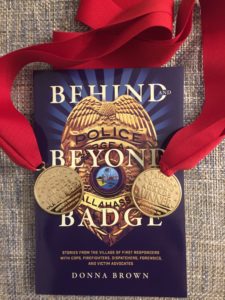
Behind and Beyond the Badge published by Storehouse Media Group, is a collection of stories about twenty-one first responders, police officers, firefighters, EMS, forensic technicians, dispatchers and victim advocates. Most people see a badge, behind and beyond the badge is what people need to know, the person. Donna feels, “My book doesn’t have the power to change minds but perhaps by offering a different perspective it can open them.”
This year due to the health, and ultimately the death, of Billie Johnson, I had to move to a new publisher. I feel most fortunate that Mike Orenduff has taken me on as one of Aakenbaaken & Kent’s authors.
My first experience with Aakenbaaken & Kent (A&K) was in producing a book as co-editor on the history of Miami, Arizona for the Bullion Plaza Museum. All proceeds go to the museum.
Then in late summer and early fall A&K republished all three of my earlier mystery books in a second edition, and formally identified them as the series, “Deputy Allred & Apache Policeman Victor, Books 1 through 3,” with a common format and cover style.
The highlight of the year was the publication on October 25, of Murder in Copper, which is book 4 of the “Deputy Allred & Apache Officer Victor” series.

In addition to my published books, I wrote and presented a paper on Wilma Gray Sain at the Arizona History Convention, and had a feature article on Alf Edwards, Miami’s first town marshal and Gila County Sheriff, in the Gateway to the Copper Corridor print magazine.
Murder in Copper ~ The Baleful Owl ~ Saints & Sinners ~ The Wham Curse ~ Miami – A History… ~ Paper, AZ History Convention
—Virgil Alexander
https://www.amazon.com/Virgil-Alexander
***
Aakenbaaken & Kent is also republishing F. M. Meredith’s (known as Marilyn Meredith in PSWA circles) Rocky Bluff P.D. series. The latest to appear on Amazon is Tangled Webs in trade paperback and for Kindle.
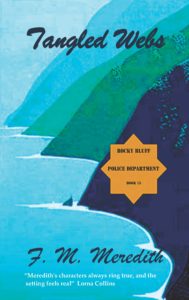
***
In November Recounting the Anthrax Attacks by PSWA member, Scott Decker, won:
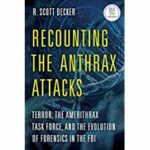
- Beverly Hills Book Awards: Winner in New (Author) Non-Fiction & Finalist in True Crime
- Best Book Awards: Winner in True Crime & Finalist in Narrative Non-Fiction
